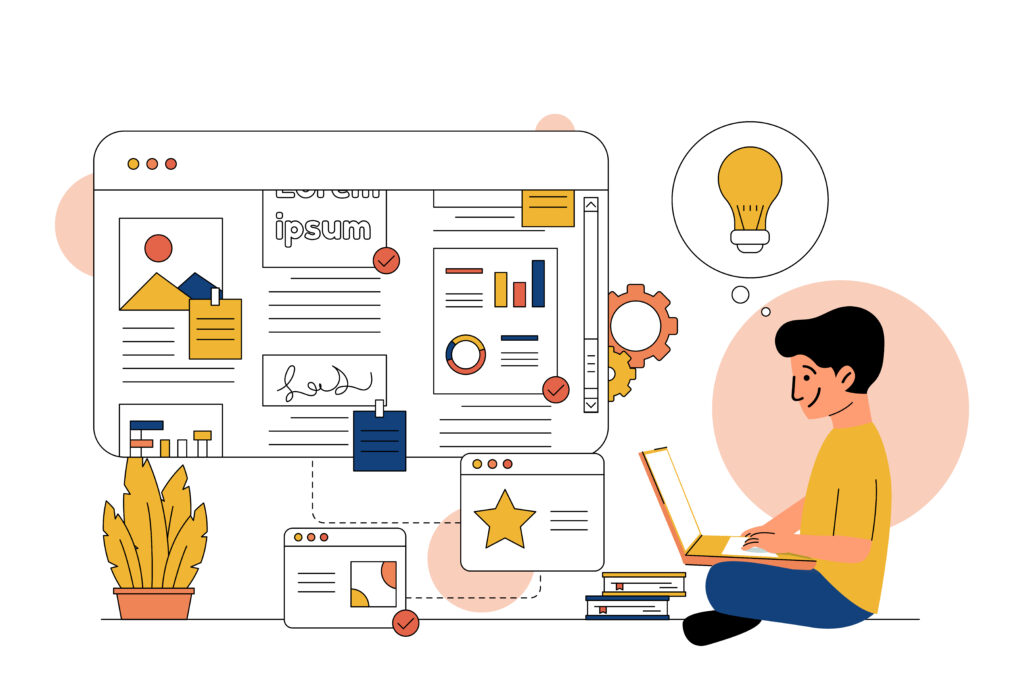As the internet becomes an increasingly integral part of our daily lives, websites have become a vital tool for businesses, organizations, and individuals. A website serves as a digital storefront, a platform for sharing information, and a means of connecting with customers or followers. The design of a website can either attract or repel visitors, making it crucial for web designers to strike a balance between aesthetics and functionality.
The Importance of Aesthetics in Web Design
First of all, what do we mean when we talk about aesthetics in web design? Aesthetics refer to the visual elements and overall look and feel of a website. They include color schemes, typography, layout, and imagery. These elements work together to create a website’s personality and style. A website’s aesthetics create a strong first impression and can convey a brand’s personality and values. Poor aesthetics may make the website appear unprofessional or untrustworthy, which can turn visitors away. On the other hand, a visually appealing website can attract visitors and encourage them to stay longer, engage with the content and ultimately become customers or supporters.
The Importance of Functionality in Web Design

The other essential part of a user-friendly and engaging website is its functionality, which basically is the usability and practicality of a website. Functionality includes navigation, accessibility, and responsiveness. It is equally important as aesthetics, as it directly affects the user experience. A website with poor functionality may be difficult to navigate, slow to load, or incompatible with certain devices. This can frustrate visitors and lead to a high bounce rate. In contrast, excellent functionality can make it easy for visitors to find what they are looking for and complete desired actions, such as making a purchase or filling out a form.
How to Balance Aesthetics and Functionality
To achieve the perfect balance between aesthetics and functionality on your website, it is essential to take a thoughtful and deliberate approach. Here are several key factors to consider:
1. Define the Website’s Purpose and Audience
Before beginning the design process, it is important to define the website’s purpose and audience. This will help guide the design decisions, ensuring that the website is tailored to the needs and expectations of the target audience. Ask yourself questions like: What is the main goal of the website? What problem does it solve for its visitors? What is the desired outcome of the visitor’s interaction with the website? For instance, the purpose of an e-commerce website is to sell products. Therefore, the design should focus on making the purchasing process as simple and intuitive as possible, displaying product images, descriptions, and prices, and making it easy for visitors to add items to their cart.
To define the target audience, it’s important to consider demographics such as age, gender, location, and interests. If the target audience of a website is young adults, the design may include bold colors, playful fonts, and interactive features such as animations and gamification. On the other hand, if the target audience is professionals, the design may be more streamlined, with a focus on functionality.
2. Choose a Simple and Consistent Design
A simple and consistent design makes it easy for visitors to navigate your website and find what they need. It can create a sense of organization and structure which helps the user to understand the content. In contrast, a cluttered or inconsistent design can make it difficult for visitors to find their way around the site, leading to a frustrating user experience.
Simplicity in design means using only the essential design elements that are necessary to communicate the message and achieve the website’s goals. This includes using a limited color palette, minimal typography, and only necessary graphics and images. By keeping the design simple, visitors can focus on the content, and the website’s purpose is communicated more effectively.
A consistent design uses the same design elements, such as typography, color scheme, and layout, throughout the website. Consistency helps users quickly learn how to navigate your website and understand how to interact with the website’s elements. This helps to create a sense of familiarity and trust.
3. Prioritize User Experience

To prioritize the user experience, you must put yourself in the shoes of the website’s visitors. You must consider factors such as the visitor’s goals and expectations, as well as the visitor’s device and internet speed. By prioritizing the user experience, you can create a website that is easy to use, engaging, and effective in achieving its intended goals.
In addition, prioritizing the user experience can help to increase visitor engagement and conversion rates. Visitors are more likely to return to a website that provides a positive user experience, and they are more likely to complete desired actions, such as making a purchase or filling out a form. By prioritizing the user experience, web designers can create a website that is not only visually stunning but also effective in achieving its intended goals.
4. Use Space Wisely
Space refers to the empty areas around and between design elements, including text, images, and graphics. It helps to create a sense of organization, hierarchy, and balance in a website’s design. There are two types of space in web design: positive space and negative space. Positive space is the area occupied by design elements, while negative space is the area around and between those elements. The effective use of negative space is essential for creating a clean and visually appealing design that is easy to navigate.
One of the primary benefits of using space effectively is the improvement of the website’s usability. Adequate white space can make it easier for visitors to read text, understand the content, and navigate the website. Conversely, cluttered and crowded design can overwhelm visitors and make it difficult for them to focus on the content. The correct use of space also enhances the website’s aesthetics. Space can be used to create balance, harmony, and contrast in the design. A well-designed website will have a balance between positive and negative space, with appropriate spacing between design elements. This can create a sense of elegance and sophistication in the design, making it visually appealing and engaging for visitors.
5. Choose Appropriate Colors and Typography

The colors and typography used on a website can significantly impact its visual appeal and readability. Therefore, it is important to choose colors and typography that are appropriate for the website’s purpose, audience, and overall design. When choosing colors for a website, you may consider the psychology of color. Different colors evoke different emotions and can have a significant impact on how visitors perceive the website. For example, blue is often associated with trust and security, while red is associated with excitement and passion. By using appropriate colors, web designers can create a website that effectively communicates its intended message and resonates with the target audience.
Typography is another important aspect of web design, as it directly impacts the readability and legibility of the website’s content. Choosing an appropriate font type and size can significantly improve the website’s user experience, making it easier for visitors to read and understand the content. When choosing typography, it’s important to consider factors such as the audience’s age, the website’s purpose, and the overall design of the website. For example, a website designed for young adults may use a playful and creative font, while a website designed for professionals may use a more conservative and traditional font.
6. Use High-Quality Visuals
High-quality visuals can enhance the visual appeal of a website, making it more engaging and memorable for visitors. However, it’s important to ensure that the visuals used on the website do not negatively impact its functionality. One of the main benefits of using high-quality visuals is that they can help to create a strong first impression for the website. When visitors arrive on a website, they often form an initial impression within seconds. High-quality visuals can help to create a positive first impression, encouraging visitors to stay on the website and engage with its content.
7. Benefit from the Latest Web Design Trends

By incorporating the latest web design trends, you can be sure that your website looks fresh and modern, resonates with visitors, and helps the website to stand out from competitors. However, it’s important to approach trends with caution. Not all of them will be appropriate for every website, audience, or purpose. Also, avoid overusing trends or incorporating them solely for the sake of keeping up with the latest design fads. Although trends can serve as a guide and provide direction, it’s always important to use them strategically and in a way that aligns with the website’s overall design and purpose.
8. Consider Mobile Responsiveness
With an increasing number of visitors accessing websites from mobile devices, it is essential to ensure that the website can be easily navigated and viewed on a variety of devices, including smartphones and tablets. A website that is not optimized for mobile can turn away potential visitors and customers.
9. Pay Attention to Accessibility

Ensuring accessibility in web design means providing alternatives for visitors who may have difficulty using certain aspects of the website. This includes adding alternative text for images, providing captions for videos, and creating a website structure that is easy to navigate using assistive technologies such as screen readers. In addition to being the right thing to do, ensuring accessibility in web design also has practical benefits. A website that is accessible to everyone is likely to have a larger audience and better user engagement. It can also help to improve the website’s search engine optimization (SEO), as search engines prefer websites that are accessible to everyone.
10. Test and Iterate
Finally, continuously testing the website’s usability, accessibility, and visual appeal, and making changes based on feedback is an essential part when balancing aesthetics and functionality. It’s important to note that testing and iterating is not a one-time process. As web design trends evolve and visitor preferences change, it’s crucial to continue testing and iterating to ensure that the website remains effective and relevant.
In Conclusion:
Aesthetics create a strong first impression and convey a brand’s personality, while functionality ensures that visitors can easily navigate the website and achieve their goals. However, overemphasizing either one of them can lead to disorder and confusion. It’s like yin and yang, you want them to be in perfect balance and harmony, so they can bring out their full potential. That is why balancing aesthetics and functionality is so important to create a visually stunning yet user-friendly website.
If you are looking for a partner who knows how to strike the perfect balance between aesthetics and functionality, schedule a consultation with us today. At Bright Development, we take a thoughtful and strategic approach to web design to ensure that your website not only looks amazing but also effectively communicates your brand message and helps you achieve your goals.


